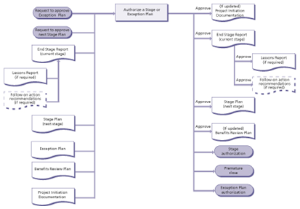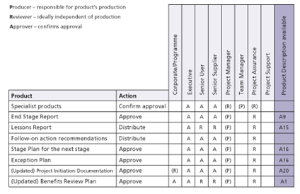PRINCE2 2009 - Directing a project part 7
of the Cabinet Office under delegated authority from the Controller of HMSO.
Activities
Authorize a Stage or Exception Plan
It is important that a stage starts only when the Project Board says it should.
The Project Board authorizes a management stage by reviewing the performance of the current stage and approving the Stage Plan for the next stage.
Approval of Stage Plans occurs at the end of every management stage except the last one.
If an exception has occurred during the stage, the Project Board may request that the Project Manager produces an Exception Plan for Project Board approval.
Only exceptions to Stage Plans or Project Plans need to be escalated for approval.
Deviations from the Project Plan may need corporate or programme management approval.
Work Package exceptions are managed by the Project Manager using the Controlling a Stage process (see the section covering ‘Controlling a stage’).
If approved, the Exception Plan will replace the plan that is in exception and will become the new baselined plan.
The Project Board may appoint Project Assurance to undertake some of the reviewing and assessing actions (e.g. inspecting the Stage Plan to confirm it is viable).
Diagram 1 shows the inputs to, and outputs from, this activity.
Diagram 1
PRINCE2® recommends the following actions:
- Review and approve the End Stage Report:
- Ascertain the performance of the project to date, asking the Project Manager to explain any deviations from the approved plans and to provide a forecast of project performance for the remainder of the project
- If required, review the Lessons Report and agree who should receive it. Ensure that the appropriate groups (for example, corporate or programme management, or a centre of excellence) have been made aware of their responsibility for taking any recommendations forward
- Check the risk summary to ensure the exposure is still acceptable and that risk responses for both opportunities and threats are appropriate and planned
- If there has been a phased handover of products during the stage:
- Verify that the product handover was in accordance with the Configuration Management Strategy and, in particular, that user acceptance, and operational and maintenance acceptance, exist for each product
- Ensure that, where appropriate, the resulting changes in the business are supported and sustainable
- Confirm who should receive which follow-on action recommendation, if any, as summarized in the End Stage Report (in some instances it may be necessary to review the detailed recommendation for some of the follow-on action recommendations). Ensure that the appropriate groups (for example, operations or maintenance) have been made aware of their responsibility for taking any recommendations forward
- Review the Stage Plan or Exception Plan for which the Project Manager is seeking approval:
- Confirm the validity and achievability of the Stage Plan/Exception Plan
- Review and approve any new Product Description(s)
- Confirm the validity and achievability of the Project Plan. If necessary, secure appropriate approvals from corporate or programme management
- Confirm the strategies and project controls in the (updated) Project Initiation Documentation are adequate for the remainder of the project
- Verify that the (updated) Business Case continues to demonstrate a viable project
- Review and approve the (updated) Benefits Review Plan to ensure that any benefits planned to be achieved within the next stage will be measured and reviewed
- Make a decision:
- Approve the plan(s) and authorize the Project Manager to proceed with the submitted plan(s):
- Obtain or commit the resources needed by the plan(s)
- Set tolerances for the plan being approved (for the final stage, the Project Board should consider whether any residual tolerances from the previous stages could be assigned to the plan or whether they are better held back in reserve)
- Or ask the Project Manager to revise the rejected plan, giving guidance about the changes required to make it acceptable
- Or instruct the Project Manager to initiate premature closure of the project
- Communicate the status of the project to corporate or programme management and keep other interested parties informed about project progress (in accordance with the Communication Management Strategy)
Diagram 2 shows the responsibilities for this activity.
Diagram 2
PRINCE2® is a Registered Trade Mark of the Office of Government Commerce in the United Kingdom and other countries.
Managing Successful Projects with PRINCE2 - 2005 edition
Managing successful Projects with PRINCE2 – 2009 edition
Directing Projects with PRINCE2.
plus:
The Complete Project Management package.
And much more besides - at a fantastic price.





